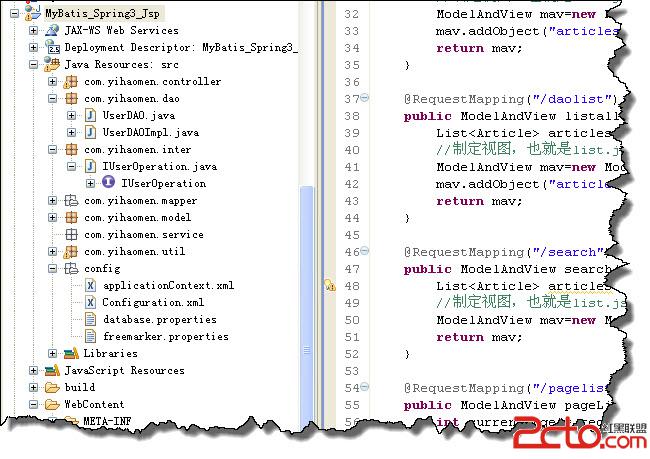mybatis入門教程(初學者必看)
什麼是mybatis
MyBatis是支持普通SQL查詢,存儲過程和高級映射的優秀持久層框架。MyBatis消除了幾乎所有的JDBC代碼和參數的手工設置以及結果集的檢索。MyBatis使用簡單的XML或注解用於配置和原始映射,將接口和Java的POJOs(Plan Old Java Objects,普通的Java對象)映射成數據庫中的記錄.
orm工具的基本思想
無論是用過的hibernate,mybatis,你都可以法相他們有一個共同點:
1. 從配置文件(通常是XML配置文件中)得到 sessionfactory.
2. 由sessionfactory 產生 session
3. 在session 中完成對數據的增刪改查和事務提交等.
4. 在用完之後關閉session 。
5. 在java 對象和 數據庫之間有做mapping 的配置文件,也通常是xml 文件。
mybatis實戰教程(mybatis in action)之一:開發環境搭建
mybatis 的開發環境搭建,選擇: eclipse j2ee 版本,mysql 5.1 ,jdk 1.7,mybatis3.2.0.jar包。這些軟件工具均可以到各自的官方網站上下載。
首先建立一個名字為 MyBaits 的 dynamic web project
1. 現階段,你可以直接建立java 工程,但一般都是開發web項目,這個系列教程最後也是web的,所以一開始就建立web工程。
2. 將 mybatis-3.2.0-SNAPSHOT.jar,mysql-connector-java-5.1.22-bin.jar 拷貝到 web工程的lib目錄.
3. 創建mysql 測試數據庫和用戶表,注意,這裡采用的是 utf-8 編碼
創建用戶表,並插入一條測試數據
程序代碼
Create TABLE `user` (
`id` int(11) NOT NULL AUTO_INCREMENT,
`userName` varchar(50) DEFAULT NULL,
`userAge` int(11) DEFAULT NULL,
`userAddress` varchar(200) DEFAULT NULL,
PRIMARY KEY (`id`)
) ENGINE=InnoDB AUTO_INCREMENT=2 DEFAULT CHARSET=utf8;
Insert INTO `user` VALUES ('1', 'summer', '100', 'shanghai,pudong');
到此為止,前期准備工作就完成了。下面開始真正配置mybatis項目了。
1. 在MyBatis 裡面創建兩個源碼目錄,分別為 src_user,test_src, 用如下方式建立,鼠標右鍵點擊 JavaResource.
2. 設置mybatis 配置文件:Configuration.xml, 在src_user目錄下建立此文件,內容如下:
程序代碼
< ?xml version="1.0" encoding="UTF-8" ?>
< !DOCTYPE configuration PUBLIC "-//mybatis.org//DTD Config 3.0//EN"
"http://mybatis.org/dtd/mybatis-3-config.dtd">
< configuration>
< /configuration>
3. 建立與數據庫對應的 java class,以及映射文件.
在src_user下建立package:com.yihaomen.mybatis.model ,並在這個 package 下建立 User 類:
程序代碼
package com.yihaomen.mybatis.model;
public class User {
private int id;
private String userName;
private String userAge;
private String userAddress;
public int getId() {
return id;
}
public void setId(int id) {
this.id = id;
}
public String getUserName() {
return userName;
}
public void setUserName(String userName) {
this.userName = userName;
}
public String getUserAge() {
return userAge;
}
public void setUserAge(String userAge) {
this.userAge = userAge;
}
public String getUserAddress() {
return userAddress;
}
public void setUserAddress(String userAddress) {
this.userAddress = userAddress;
}
}
同時建立這個User 的映射文件 User.xml:
程序代碼
< ?xml version="1.0" encoding="UTF-8" ?>
< !DOCTYPE mapper PUBLIC "-//mybatis.org//DTD Mapper 3.0//EN"
"http://mybatis.org/dtd/mybatis-3-mapper.dtd">
< mapper namespace="com.yihaomen.mybatis.models.UserMapper">
select * from `user` where id = #{id}
< /mapper>
下面對這幾個配置文件解釋下:
1.Configuration.xml 是 mybatis 用來建立 sessionFactory 用的,裡面主要包含了數據庫連接相關東西,還有 java 類所對應的別名,比如
這個別名非常重要,你在 具體的類的映射中,比如User.xml 中 resultType 就是對應這裡的。要保持一致,當然這裡的 resultType 還有另外單獨的定義方式,後面再說。是包含要映射的類的xml配置文件。mybatis實戰教程(mybatis in action)之二:以接口的方式編程
重寫測試代碼 程序代碼 public static void main(String[] args) { SqlSession session = sqlSessionFactory.openSession(); try { IUserOperation userOperation=session.getMapper(IUserOperation.class); User user = userOperation.selectUserByID(1); System.out.println(user.getUserAddress()); System.out.println(user.getUserName()); } finally { session.close(); } } 整個工程結構圖現在如下: 運行這個測試程序,就可以看到結果了。 除非申明,文章均為一號門原創,轉載請注明本文地址,謝謝! mybatis實戰教程(mybatis in action)之三:實現數據的增刪改查 前面已經講到用接口的方式編程。這種方式,要注意的一個地方就是。在User.xml 的配置文件中,mapper namespace="com.yihaomen.mybatis.inter.IUserOperation" ,命名空間非常重要,不能有錯,必須與我們定義的package 和 接口一致。如果不一致就會出錯,這一章主要在上一講基於接口編程的基礎上完成如下事情: 1. 用 mybatis 查詢數據,包括列表 2. 用 mybatis 增加數據 3. 用 mybatis 更新數據. 4. 用 mybatis 刪除數據. 查詢數據,前面已經講過簡單的,主要看查詢出列表的 查詢出列表,也就是返回list, 在我們這個例子中也就是 List , 這種方式返回數據,需要在User.xml 裡面配置返回的類型 resultMap, 注意不是 resultType, 而這個resultMap 所對應的應該是我們自己配置的 程序代碼 < !-- 為了返回list 類型而定義的returnMap --> 查詢列表的語句在 User.xml 中 程序代碼 < !-- 返回list 的select 語句,注意 resultMap 的值是指向前面定義好的 --> selectUsers(String userName); users = userOperation.selectUsers(userName); useGeneratedKeys="true" keyProperty="id"> mybatis實戰教程(mybatis in action)之四:實現關聯數據的查詢
select user.id,user.userName,user.userAddress,article.id aid,article.title,article.content from user,article where user.id=article.userid and user.id=#{id} mybatis實戰教程(mybatis in action)之五:與spring3集成(附源碼)
mybatis實戰教程(mybatis in action)之六:與Spring MVC 的集成
contextConfigLocation classpath*:config/applicationContext.xml org.springframework.web.context.ContextLoaderListener mvc-dispatcher org.springframework.web.servlet.DispatcherServlet 1 mvc-dispatcher / xmlns:context="http://www.springframework.org/schema/context" class="org.springframework.web.servlet.view.InternalResourceViewResolver">/WEB-INF/pages/ .jsp destroy-method="close" p:driverClassName="com.mysql.jdbc.Driver" ,所有這些都交給 在配置 sqlSessionFactory 的時候,由 去導入了。mybatis實戰教程(mybatis in action)之七:實現mybatis分頁(源碼下載)
select user.id,user.userName,user.userAddress,article.id aid,article.title,article.content from user,article where user.id=article.userid and user.id=#{id} limit #{offset},#{pagesize} map = (Map)parameterObject; parameterMappings = boundSqlmybatis實戰教程(mybatis in action)之八:mybatis 動態sql語句
select * from t_blog where 1 = 1 and title = #{title} and content = #{content} and owner = #{owner} select * from t_blog where 1 = 1 and title = #{title} and content = #{content} and owner = "owner1" select * from t_blog title = #{title} and content = #{content} or owner = #{owner} select * from t_blog title = #{title} and content = #{content} and owner = #{owner}
程序代碼 程序代碼
update t_blog
title = #{title},
content = #{content},
owner = #{owner}
where id = #{id}
select * from t_blog where id in #{item} dynamicForeachTest(List ids);
程序代碼 程序代碼
@Test
public void dynamicForeachTest() {
SqlSession session = Util.getSqlSessionFactory().openSession();
BlogMapper blogMapper = session.getMapper(BlogMapper.class);
List ids = new ArrayList();
ids.add(1);
ids.add(3);
ids.add(6);
List blogs = blogMapper.dynamicForeachTest(ids);
for (Blog blog : blogs)
System.out.println(blog);
session.close();
}
select * from t_blog where id in #{item} dynamicForeach2Test(int[] ids); select * from t_blog where title like "%"#{title}"%" and id in #{item} dynamicForeach3Test(Map params);
程序代碼 程序代碼
Drop TABLE IF EXISTS `category`;
Create TABLE `category` (
`id` int(11) NOT NULL AUTO_INCREMENT,
`catname` varchar(50) NOT NULL,
`catdescription` varchar(200) DEFAULT NULL,
PRIMARY KEY (`id`)
) ENGINE=InnoDB DEFAULT CHARSET=utf8;
程序代碼 程序代碼
< ?xml version="1.0" encoding="UTF-8"?>
< !DOCTYPE generatorConfiguration
PUBLIC "-//mybatis.org//DTD MyBatis Generator Configuration 1.0//EN"
"http://mybatis.org/dtd/mybatis-generator-config_1_0.dtd">
< generatorConfiguration>
connectionURL="jdbc:mysql://127.0.0.1:3306/mybatis?characterEncoding=utf8"
userId="root"
password="password">
enableCountByExample="false" enableUpdateByExample="false"
enableDeleteByExample="false" enableSelectByExample="false"
selectByExampleQueryId="false">
< /generatorConfiguration>
程序代碼 程序代碼
package com.yihaomen.test;
import java.io.File;
import java.io.IOException;
import java.sql.SQLException;
import java.util.ArrayList;
import java.util.List;
import org.mybatis.generator.api.MyBatisGenerator;
import org.mybatis.generator.config.Configuration;
import org.mybatis.generator.config.xml.ConfigurationParser;
import org.mybatis.generator.exception.InvalidConfigurationException;
import org.mybatis.generator.exception.XMLParserException;
import org.mybatis.generator.internal.DefaultShellCallback;
public class GenMain {
public static void main(String[] args) {
List warnings = new ArrayList();
boolean overwrite = true;
String genCfg = "/mbgConfiguration.xml";
File configFile = new File(GenMain.class.getResource(genCfg).getFile());
ConfigurationParser cp = new ConfigurationParser(warnings);
Configuration config = null;
try {
config = cp.parseConfiguration(configFile);
} catch (IOException e) {
e.printStackTrace();
} catch (XMLParserException e) {
e.printStackTrace();
}
DefaultShellCallback callback = new DefaultShellCallback(overwrite);
MyBatisGenerator myBatisGenerator = null;
try {
myBatisGenerator = new MyBatisGenerator(config, callback, warnings);
} catch (InvalidConfigurationException e) {
e.printStackTrace();
}
try {
myBatisGenerator.generate(null);
} catch (SQLException e) {
e.printStackTrace();
} catch (IOException e) {
e.printStackTrace();
} catch (InterruptedException e) {
e.printStackTrace();
}
}
}
程序代碼 程序代碼
enableCountByExample="false" enableUpdateByExample="false"
enableDeleteByExample="false" enableSelectByExample="false"
selectByExampleQueryId="false"
程序代碼 程序代碼
package com.yihaomen.dao;
import java.util.List;
import com.yihaomen.model.Article;
public interface UserDAO {
public List
getUserArticles(int userid);
}
程序代碼 程序代碼
package com.yihaomen.dao;
import java.util.List;
import org.mybatis.spring.support.SqlSessionDaoSupport;
import org.springframework.stereotype.Repository;
import com.yihaomen.model.Article;
@Repository
public class UserDAOImpl extends SqlSessionDaoSupport implements UserDAO {
@Override
public List
getUserArticles(int userid) {
return this.getSqlSession().selectList("com.yihaomen.inter.IUserOperation.getUserArticles",userid);
}
}
這樣在需要調用的地方,就可以使用autowire自動注入了。 等這樣的。
程序代碼 程序代碼
@Autowired
UserDAO userDAO;
.......
@RequestMapping("/daolist")
public ModelAndView listalldao(HttpServletRequest request,HttpServletResponse response){
List
articles=userDAO.getUserArticles(1);
//制定視圖,也就是list.jsp
ModelAndView mav=new ModelAndView("list");
mav.addObject("articles",articles);
return mav;
}
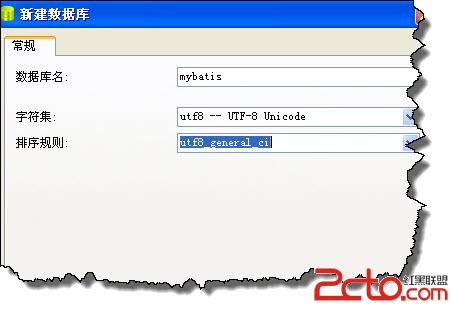
 程序代碼
程序代碼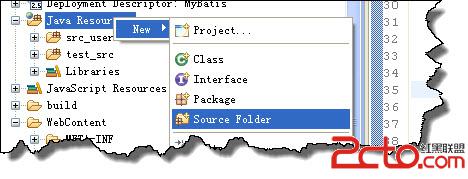
 程序代碼
程序代碼 程序代碼
程序代碼 程序代碼
程序代碼 程序代碼
程序代碼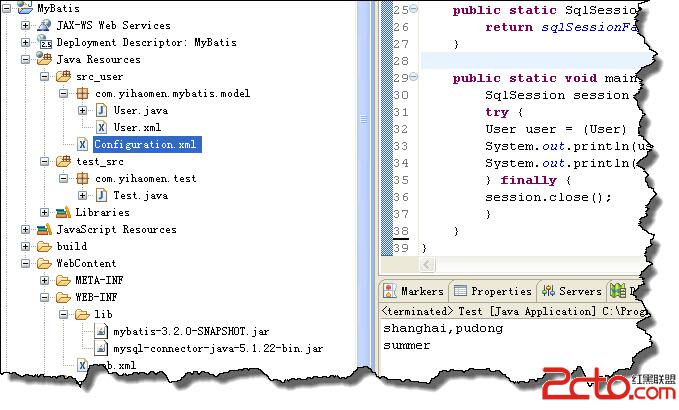
 程序代碼
程序代碼 程序代碼
程序代碼 程序代碼
程序代碼 程序代碼
程序代碼 程序代碼
程序代碼 程序代碼
程序代碼 程序代碼
程序代碼 程序代碼
程序代碼 程序代碼
程序代碼 程序代碼
程序代碼 程序代碼
程序代碼 程序代碼
程序代碼 程序代碼
程序代碼 程序代碼
程序代碼 點擊下載此文件
點擊下載此文件 程序代碼
程序代碼 程序代碼
程序代碼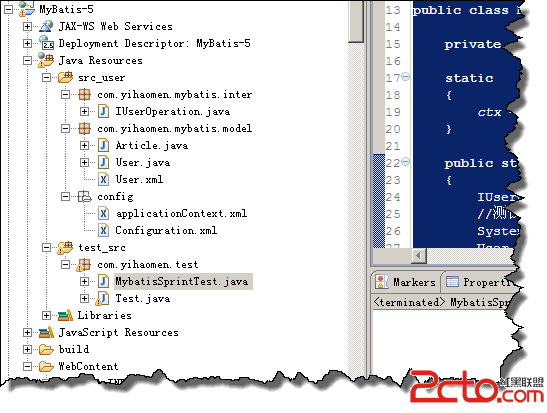
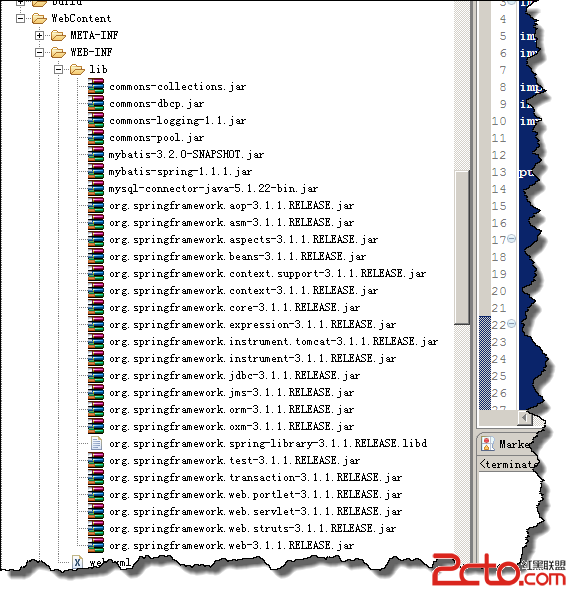
 點擊下載此文件
點擊下載此文件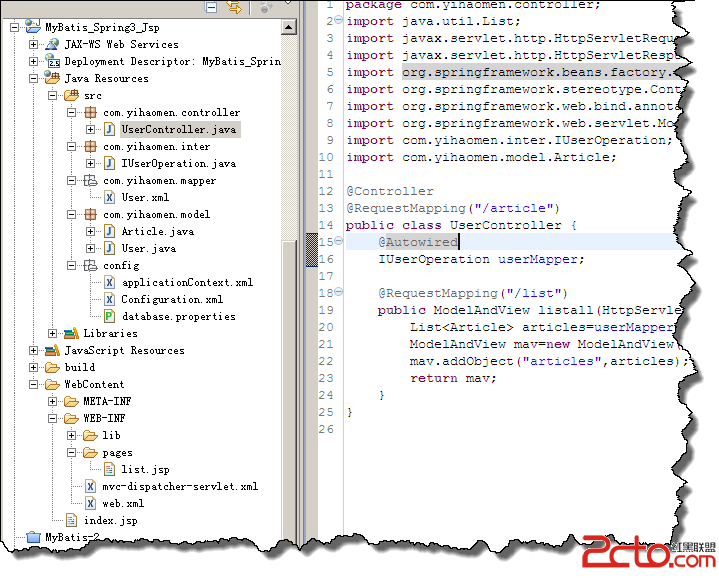
 程序代碼
程序代碼 程序代碼
程序代碼 程序代碼
程序代碼 程序代碼
程序代碼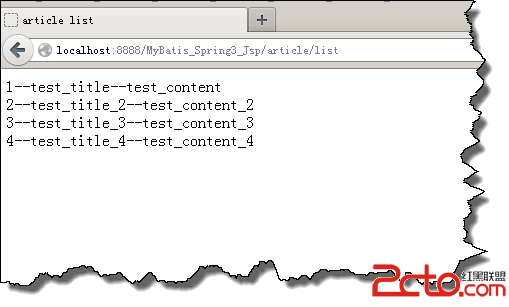
 mybatis spring3 MVC 程序下載
mybatis spring3 MVC 程序下載 spring mvc 數據庫測試文件
spring mvc 數據庫測試文件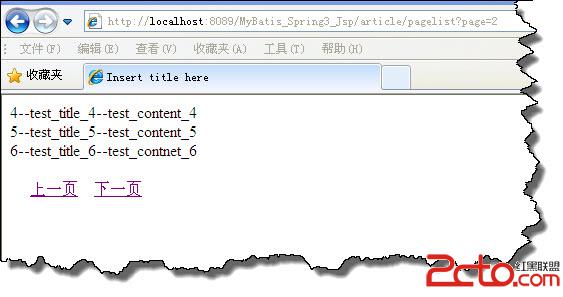
 程序代碼
程序代碼 程序代碼
程序代碼 程序代碼
程序代碼 程序代碼
程序代碼
 點擊下載此文件
點擊下載此文件 程序代碼
程序代碼 程序代碼
程序代碼 程序代碼
程序代碼 程序代碼
程序代碼 程序代碼
程序代碼 程序代碼
程序代碼 程序代碼
程序代碼 程序代碼
程序代碼 程序代碼
程序代碼 程序代碼
程序代碼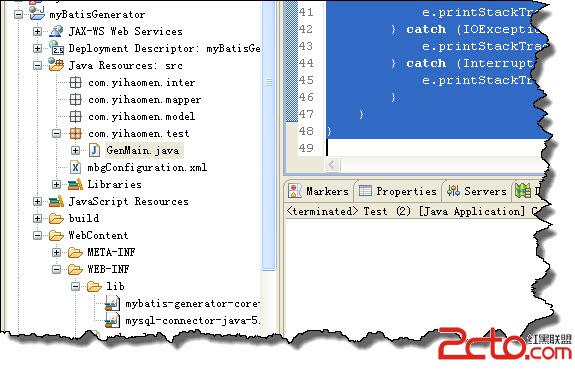
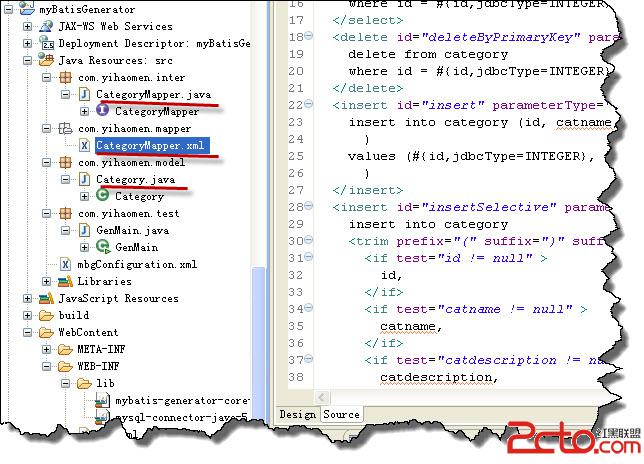
 程序代碼
程序代碼